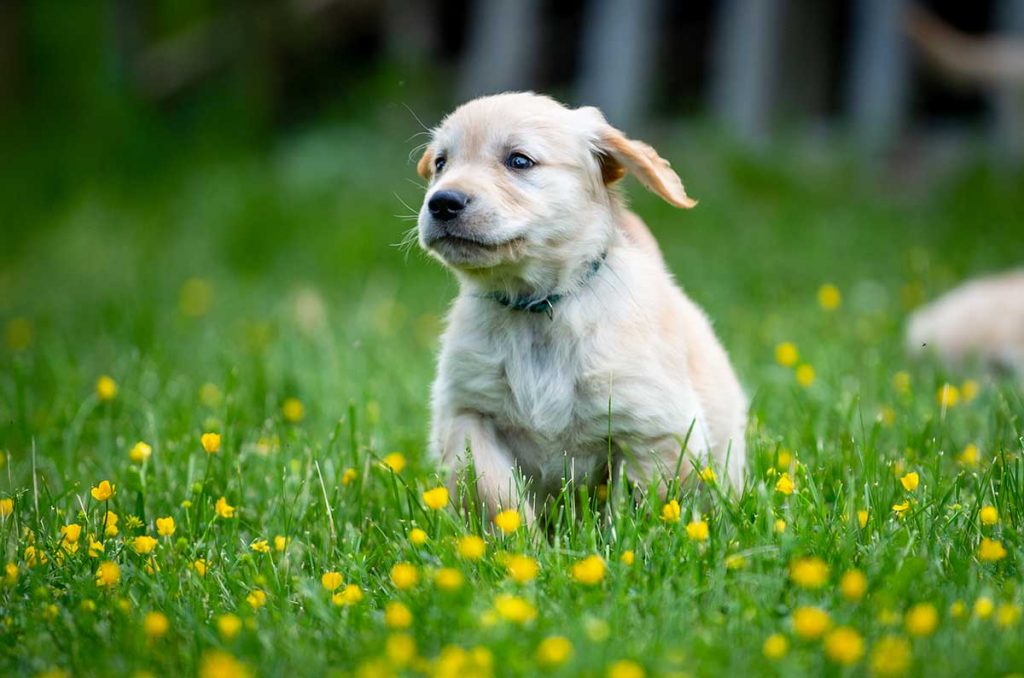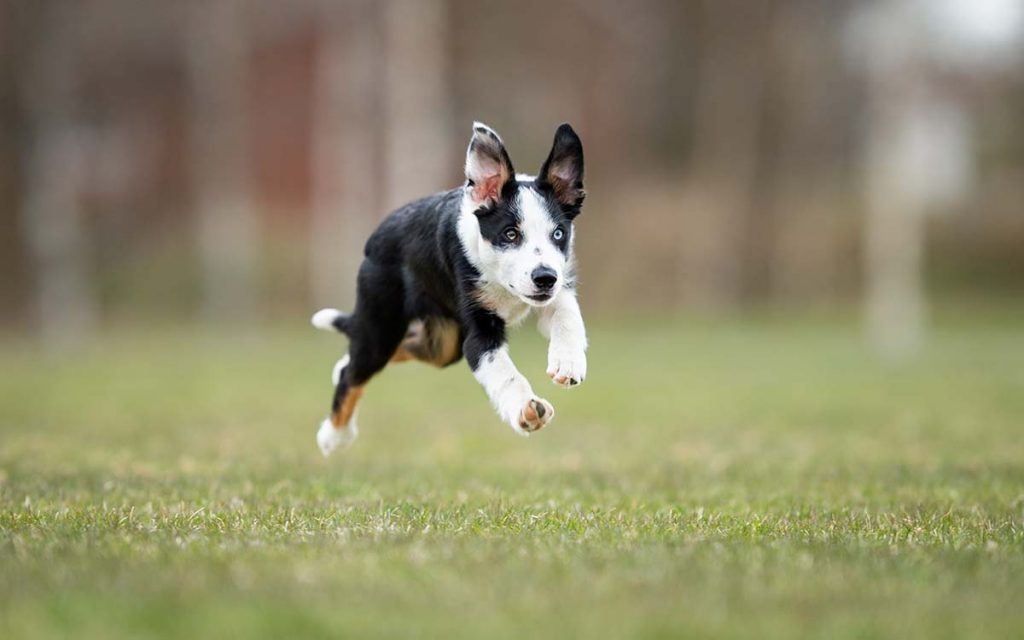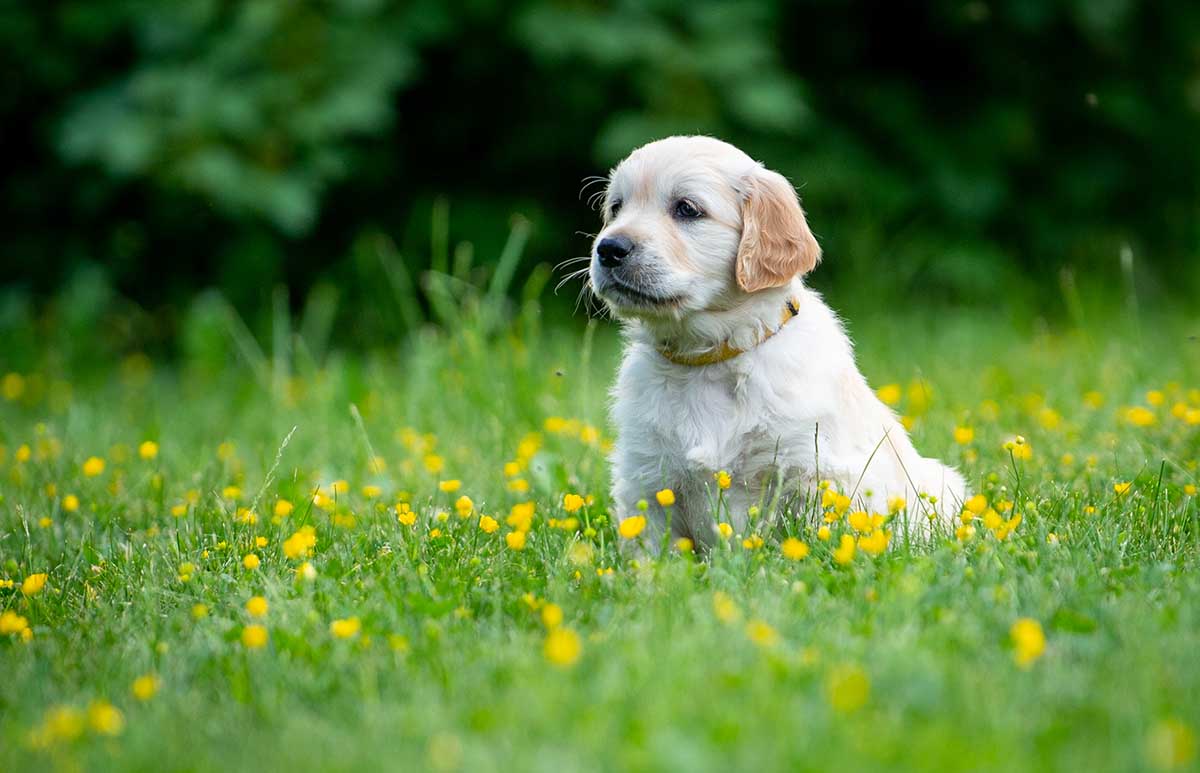01 Oct Puppy’s first weeks at home
Author Sari Paavilainen, 30 May 2017
Dreaming of a new puppy usually involves picturing a rosy future with a beautifully behaved dog. Often, however, as that heady puppy smell vanishes, the rose-coloured glasses come off and the challenges start setting in. Your cute youngster pulls at the leash, barks at other dogs, ignores recalls, jumps at people, bites your hands – you name it.
What should you do in the puppy’s first weeks at home? At what point should you start training your puppy, and how much should you train? Should you wait until your puppy is fully vaccinated?
These days, most breeders are well-informed and provide new owners with good instructions. Most puppy buyers, too, are well-informed and know what to do with their new puppy. So if all this is familiar to you, go ahead and congratulate yourself!
“The purpose of training is to make your dog want the same things you do. What could be more reasonable or more effective? Nothing.”
Immunisation
In the old days, owners were encouraged not to take their puppies beyond the home and backyard until they were fully immunised. However, the whole vaccination schedule is designed around the mother transferring maternal antibodies to her litter. The idea is that, if the mother is appropriately vaccinated, the puppies won’t need their first vaccinations until the maternal immunity begins to drop. Maternal antibodies are believed to protect puppies to up to 12 weeks old. If the mother has been vaccinated according to the recommended vaccination schedule, the puppies are considered to be protected.
Depending on your country’s vaccination schedule, your puppy will typically receive its last vaccination in the puppy shot series at around 16 weeks of age. If you only start socialising your puppy at this age, you are too late. The socialisation window for dogs, i.e. the critical period during which socialising puppies is the easiest, closes at around 16 weeks. Dogs without proper early socialisation are more likely to have behavioural problems. Socialisation and environmental training, i.e. introducing puppies to new places, should begin with the breeder, who should take the puppies, accompanied by their mother, to suitable new environments. If you are getting a puppy, offer the breeder your help!
Before the age of four months, puppies should gain positive experiences of all things that will be part of their normal life. This also includes experiences of different kinds of dogs. With so many breeds available, dogs really do come in all shapes and sizes. Simply having several dogs at home or having the puppy socialise with its littermates and the breeder’s adult dogs is not enough. To have good social skills with other dogs, puppies should have positive encounters with different dogs at least weekly until they turn six months. Many dog trainers and training centres offer puppy playgroups in which puppies can safely play with other pups.
So don’t wait for your puppy to receive the full series of puppy vaccinations. Take your pup out in public before that.
“You can give all of your puppy’s daily food in training sessions throughout the day – you really do not need a feeding bowl at all. Little by little, you will see the wanted behaviours increase and the unwanted behaviours fade away.”

Before the age of four months, puppies should be exposed to positive experiences with everything that will be part of their normal life.
Puppies learn whether you train them or not
Puppies soak up information all the time – whether you are knowingly training them or not. If it is not you doing the training, i.e. controlling the reinforcements, your puppy will learn randomly. So start training your pup as soon as you bring it home, preferably with the help of a professional trainer.
You will see best results when you teach the puppy to understand what you want. Capture any behaviours you want to reinforce as the puppy goes about doing things, and ignore any unwanted behaviours.
You can give all of your puppy’s daily food in training sessions throughout the day – you really do not need a feeding bowl at all. Little by little, you will see the wanted behaviours increase and the unwanted behaviours fade away.
You can stop reinforcing a behaviour when it is no longer necessary or you no longer need to feed your dog to elicit the behaviour. But because dogs have to be fed no matter what, why not use their meals to reinforce desired actions? Pick a behaviour that needs work and start reinforcing it. When your dog is two or three, you can stop reinforcing behaviours – if they are strong enough. Personally, I reward my dogs for certain things, such as recall, throughout their life.
But surely you must tell your puppy not to do things?
In dog training, we humans are hardwired to react to unwanted behaviour, leading us to say ‘no’ a lot. Unfortunately, constantly saying no to our dogs comes with consequences:
- Dogs will live in a negative world of forbidden things, and the ‘no’s only get sterner as they grow accustomed to punishments.
- Even though you are telling them ‘no’, dogs will not know what they are expected to do.
- Dogs will become passive, which will reduce their quality of life. Constantly saying ‘no’ will make us feel bad, too, as it sparks a negative emotional reaction in our bodies.
How would you feel if your boss or spouse only told you what you should not do, but not what you should do to earn your pay or affection?
Even though the human brain is more evolved than that of dogs, we cannot properly understand negation, either. See for yourself. First I will ask you not to think about something, then decide what to think about instead. Okay, here goes:
- Do not think about a yellow elephant.
What did you decide to think about? And what did you actually think about? Did you picture a yellow elephant or something else?
Instead of saying ‘no’ to my dogs, I use the recall cue to stop any unwanted behaviour. This gives me a chance to repeatedly practice and reinforce this vital skill in different situations and environments. It also improves my relationship with my dog, because this method involves no conflict.
But positive reinforcement training is not the same as permissive training. On the contrary, a smart use of rewards gives you the best behaved and most obedient dogs. The purpose of training is to make your dog want the same things you do. What could be more reasonable or more effective? Nothing.

When you get your puppy to understand what you want it to do, you will see the best results. Capture any behaviours you want to reinforce as the puppy goes about doing things.
The agony year
When puppies hit the age of five or six months, they enter the adolescent stage – or ‘agony year’, as I like to call it – and become increasingly interested in the outside world. At this point, treats and praise start losing their value. Puppies don’t do this out of spite, however, or to defy us. They just realise that the world is full of interesting things to explore, and it is impossible for them to understand why they should not explore it. Plain and simple, puppies choose things that interest them. If at this point we decide to tell them not to do that and use force and punishment to bend them to our will, we may ruin our relationship with the dog – and suffer the consequences all through the dog’s life. In my opinion, the whole concept of a ‘rebellious stage’ should be buried and forgotten.
Because there’s no escaping the agony year, prepare for it by working with your puppy. In the puppy’s first five months, reinforce desired behaviours as much as you possibly can, and work especially on the puppy staying near you. Because puppies like to naturally keep close to their owner, people tend to ignore it when they do so. In general, puppies won’t start to pull at the leash until after the five-month mark, when they become interested in new smells. Your puppy walking beautifully on leash until this age means nothing, and I mean absolutely nothing – zero, zilch, zip, nada – if you do not systematically reinforce this behaviour. So reinforce the heck out of all the desired behaviours your puppy offers while it is still easy. If you don’t reinforce these behaviours, you can be sure that they will vanish as you enter the agony year.
The agony year begins when the puppy is about six months and lasts for a year or so. For owners, the agony year is the most challenging time in their dog’s life. No matter how exemplary your training was in those first six months, your puppy is too young to have established strong behaviours. As you enter the agony year, creating strong behaviours becomes more challenging. When the dog turns 18 months, life gets easier again – at least with females. From the age of two, most bitches will have matured into nice and easy dogs (if you’ve been doing the right things, that is). In males, hormones and interest in the opposite sex may mean that you might have to wait a little bit longer for that easy life. But, as in everything, individual differences are common.
The teenage dog who knows its stuff
I want to point out something worth noting: when you train your dog using positive reinforcement, you will get a teenage dog who knows its stuff. And a teenage dog who gets to show off its skills is a happy teenage dog indeed. So keep your training sessions at a level where your dog can perform well and feel it is succeeding and getting the reward it wants. Praise generously, letting your dog really know what a good dog it is. Soon you will see how your teenage dog – instead of endlessly exploring the world – will start to show off its skills when doing the things you ask of it. This will create a deeper bond with your dog and help your dog develop a healthy self-esteem. And that’s cause enough for a little showing off yourself!
In sum, start reinforcing wanted behaviours as soon as you bring your puppy home, or, better still, when your puppy is still living with the breeder. And bear in mind that if you are not teaching your puppy, the pup will be learning other things on its own.

Reinforce the heck out of all desired behaviours your puppy offers while it is still easy to do, i.e. before your puppy turns six months.
Author Sari Paavilainen
Sari qualified as an animal trainer in 2010 and has worked as a dog trainer since 2003. Before her career in dog training, she trained and competed in national working dog sports (person search, tracking and versatility), competition obedience, and search and rescue. Sari is interested in trying all things new. For example, she has piloted ID tracking and marine search and rescue in Finland. Sari currently has two border collies, two Icelandic horses and fourteen sheep. She’s currently working on a tracking project entitled ‘Dogs’ limits’. She also runs an animal actor school at her training centre.



No Comments